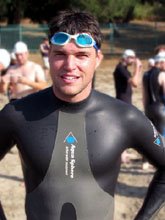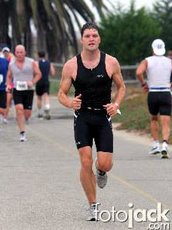 The Los Angeles Marathon is coming up this Sunday, and in honor of that, and to counterbalance the bizarre fantasia that I sent out as a fitness tip last week, I thought I'd write about running this week, or what I like to call The Workout of the Compulsive Gambler.
The Los Angeles Marathon is coming up this Sunday, and in honor of that, and to counterbalance the bizarre fantasia that I sent out as a fitness tip last week, I thought I'd write about running this week, or what I like to call The Workout of the Compulsive Gambler. I call it that because if running is your primary mode of exercise, the road leads rapidly towards one of two possible paths: glory or oblivion. Running long and hard and frequently will do one of two things to you: get you leaner and more muscular and fit than you ever dreamed possible, OR, alternatively, leave you hobbling around on gimpy knees, wincing at every stab of back pain while you tell your friends AGAIN that it's all worth it because you finally broke 3:45 in the Annual Freckles Valley Marathon back in ought-seven. Guess which outcome is more likely?
I call it that because if running is your primary mode of exercise, the road leads rapidly towards one of two possible paths: glory or oblivion. Running long and hard and frequently will do one of two things to you: get you leaner and more muscular and fit than you ever dreamed possible, OR, alternatively, leave you hobbling around on gimpy knees, wincing at every stab of back pain while you tell your friends AGAIN that it's all worth it because you finally broke 3:45 in the Annual Freckles Valley Marathon back in ought-seven. Guess which outcome is more likely?Now, I'm not here to slag off on running. I just put in six miles or so yesterday and it felt great. But as with any other form of exercise, there are measures you can take which will increase your likelihood of injury and pain, and others that will increase your likelihood of greater fitness, health and satisfaction. Below are a handful of running tips to maximize you chances before you hit those blackjack tables.
Let's start with the pros of running. Arguably, the fitness industry really started with the running craze that started to heat up as long ago as the 50's and really hasn't stopped since. Running, in all its forms, remains the most popular form of exercise in the world, far surpassing cycling, swimming, weight training or any Bikram-Style-Tae-Yogic-Pilato-Jazzer-Bob-Greene-Jane-Fondercise class you can conceive of as the #1 fitness activity in the world.
 Those millions of people are on to something: running has many unparalleled benefits. For all the fancy elliptical trainers and Hang-From-the-Ceiling-inators out there, there's not much that beats good old-fashioned running for caloric burn, fitness, and, not insignificantly, convenience. All the equipment you'll ever need for this wondrous exercise program is a decent pair of running shoes and some sweats. No memberships, no hidden fees, no trainer balancing you on a rubber ball and throwing weighted plates at you in the name of "functional" training. No matter where you are — home, New Delhi, Alaska — walk out your front door and there's your gym. So running has a lot to recommend it.
Those millions of people are on to something: running has many unparalleled benefits. For all the fancy elliptical trainers and Hang-From-the-Ceiling-inators out there, there's not much that beats good old-fashioned running for caloric burn, fitness, and, not insignificantly, convenience. All the equipment you'll ever need for this wondrous exercise program is a decent pair of running shoes and some sweats. No memberships, no hidden fees, no trainer balancing you on a rubber ball and throwing weighted plates at you in the name of "functional" training. No matter where you are — home, New Delhi, Alaska — walk out your front door and there's your gym. So running has a lot to recommend it.But hold on there, cowpoke — there's a dark side to running, and we'd best shed a little light on it before you hit the trail. Told to "get in shape" by a doctor, by your own sense of mortality, by an online fitness nag, usually the first tentative step we take is to start running. We figure we know how to run. I mean, babies run. It's not hard, isn't that sort of the point of it? There's no SKILL to LEARN. So we never consult a pro the way we might if we decided to take up swimming or golf. As a result, the running form we start with on day one of our fitness program is the same form we keep three years later when we've lost 25 pounds and look fabulous.
So what's wrong with that?
Well — a lot, frankly. I see and hear about a lot of running injuries as a trainer: veteran long-distance folks complain of chronic pain in knees, back, necks, even shoulders from the years of pounding. Now, some bodies just can't take running, that's a fact, but I'd wager (we're talking gambling this week, remember) that a lot of these overuse injuries could have been avoided with a little coaching from the start.
Watch a baby run sometime. For sheer form, my two-and-a-half-year-old daughter Kate would give an Olympic track star a run for her money. When she runs, she's relaxed, aligned, joyous. But between the time we start running as babies and the time we initiate our get-in-shape-for-the-beach programs lie several decades of physical misuse. Forget diet — which is certainly a factor — I'm talking about poor postural habits, tension, injuries, plummeting stock market indices, kids and a mortgage — the kind of stuff that makes our shoulders hunch and our hamstrings shorten. Stuff that subtly throws off our gait in ways we might not notice till Month Six and Mile 315 of our running program when suddenly it feels like someone just Nancy Kerrigan-ed our right ACL.
So, yes, shockingly, we really DO have to relearn to run. Most recreational runners have never been coached on form before — and many of them will pay the price years down the line in overuse injuries. These injuries ARE avoidable — if we just pay a little attention to form.
And what's good running form? Essentially, there are four points of focus (cribbed, in large part, I have to admit, from Joe Friel, author of The Triathlete's Training Bible — and countless articles in Runner's World and elsewhere. Thanks, Joe!):
1) Relax the upper body… You don't need 90% of the tension that tends to accumulate above the waist when you run. So relax the face and jaw, relax the hands, let the shoulders swing easily and loosely. Ever seen the faces of elite runners in slo-mo? They look like melting wax. It's not pretty, but that's the look you want to cultivate.
2) …but don't collapse: It's easy to take the above pointer as an excuse to collapse, let gaze fall to your feet and sleepwalk through your running session. Don't go that far. Pretend you've got a cape billowing off your shoulders. Stand up and level your gaze at the horizon. This is called running "proud." Most people run with their butts sticking out behind them, and it's very inefficient: keep your hips right underneath your shoulders, like you're riding a unicycle, and you'll save yourself a lot of energy. In a word, strive for good posture. Hard to do while "relaxing," you say? Try it for awhile and pretty soon running proud will feel easy and natural.
3) Take shorter, quicker steps. The fastest, most efficient runners take about 90 step-cycles (i.e., right-foot strikes) per minute. This is whether they are running quickly or slowly—among elite runners, speed is determined primarily by stride length, not cadence. So take shorter, faster steps, aiming for 90 cycles/minute, and save yourself some pounding. At first you will feel like you're speed walking and it may even feel more tiring. But stick with it — as with running proud, it gets easier and the rewards are great.
4) Think "Kick Back" NOT "Stride Forward." Most runners over-stride — they kick their feet way out in front of them with each step, especially when accelerating. Reaching out with your feet in this way, beyond the plane of your body, is very tough on the knees AND it slows you down: the heel striking the ground decelerates the body and with each step you have to work harder to speed yourself up again. Strive instead for each step to land on a plumb-line directly below your hip and shoulder, then "paw" the ground below you, focusing on kicking each foot back and up, pushing back with the hamstrings and glutes to gain speed.
When you first start trying to run this way, you will undoubtedly feel awkward, more tired, perhaps sore afterwards. You'll wonder why you ever started analyzing your running in this way, and you may have the impulse to send me hate mail.
 But hang in there: work on the first couple of pointers one day, the second two another day, and pretty soon it will come together for you. You'll be running further, faster, and more efficiently, and before you know it you'll look and feel like the gazelles that front-run at the L.A. Marathon every year.
But hang in there: work on the first couple of pointers one day, the second two another day, and pretty soon it will come together for you. You'll be running further, faster, and more efficiently, and before you know it you'll look and feel like the gazelles that front-run at the L.A. Marathon every year.The race route goes right by my house, and it's become an annual tradition in our house to get up early enough on the Sunday to watch the leaders — Kenyans, inevitably — come loping by a good hour or so ahead of everyone else. If you get the chance, I'd highly recommend taking it in: their form is impeccable. They look like they're flying, you can barely hear their feet touching the ground, even though they're logging sub-five minute miles for over two hours straight. They're running proud, and well they should.
Good luck!
Andrew




No comments:
Post a Comment